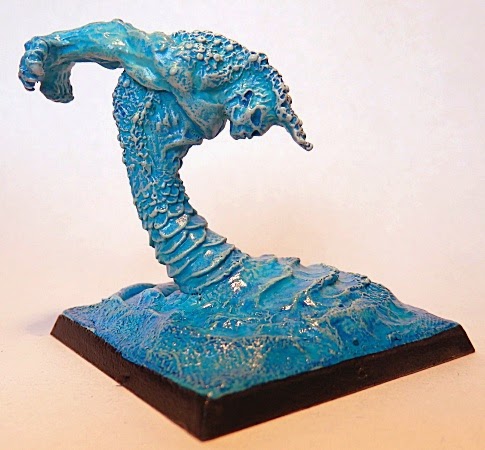 And a final update of the figures I've been working on this month. Again, these were originally part of a Centaur HOTT army that got too large, and these guys didn't make the final cut - but I've kept them as separate figures for D&D purposes.
And a final update of the figures I've been working on this month. Again, these were originally part of a Centaur HOTT army that got too large, and these guys didn't make the final cut - but I've kept them as separate figures for D&D purposes.  The one with the spear is what I would call a "traditional" Asgard sculpt - a bit coarse and lacking in detail (especially around the face!) but still with a lot of energy. The one with the bow is a reworking by Asgard of a figure from their Barbarian Personalities range - if you look at this picture of BP7 Arflane the Archer, you can see that they've taken the upper body, attached it to a horse torso and then modelled a cloak and belt to conceal the join. Whilst I can admire the re-use, IMHO the figure does feel very static compared to the "traditional" sculpt.
The one with the spear is what I would call a "traditional" Asgard sculpt - a bit coarse and lacking in detail (especially around the face!) but still with a lot of energy. The one with the bow is a reworking by Asgard of a figure from their Barbarian Personalities range - if you look at this picture of BP7 Arflane the Archer, you can see that they've taken the upper body, attached it to a horse torso and then modelled a cloak and belt to conceal the join. Whilst I can admire the re-use, IMHO the figure does feel very static compared to the "traditional" sculpt.
Both figures were a pleasure to deal with - mostly woodland shades as base colours then Army Painter soft tone for a wash, followed by highlighting. The bow centaur is a more detailed figure, and benefitted most from this, whilst the spear figure didn't come up as well as I would have liked - the lack of detail on the figure really didn't help. The bases are simply flock and artificial grass.
Pleased with both paint jobs on the whole, but to be honest I can't see the archer getting too much table top time - but his friend with the spear will!















.JPG)
.JPG)
.JPG)
.JPG)







.jpg)
.jpg)
.jpg)



+Range+FA10+Armoured+Centaur+%231+.jpg)
+Range+FA10+Armoured+Centaur+%232.jpg)



